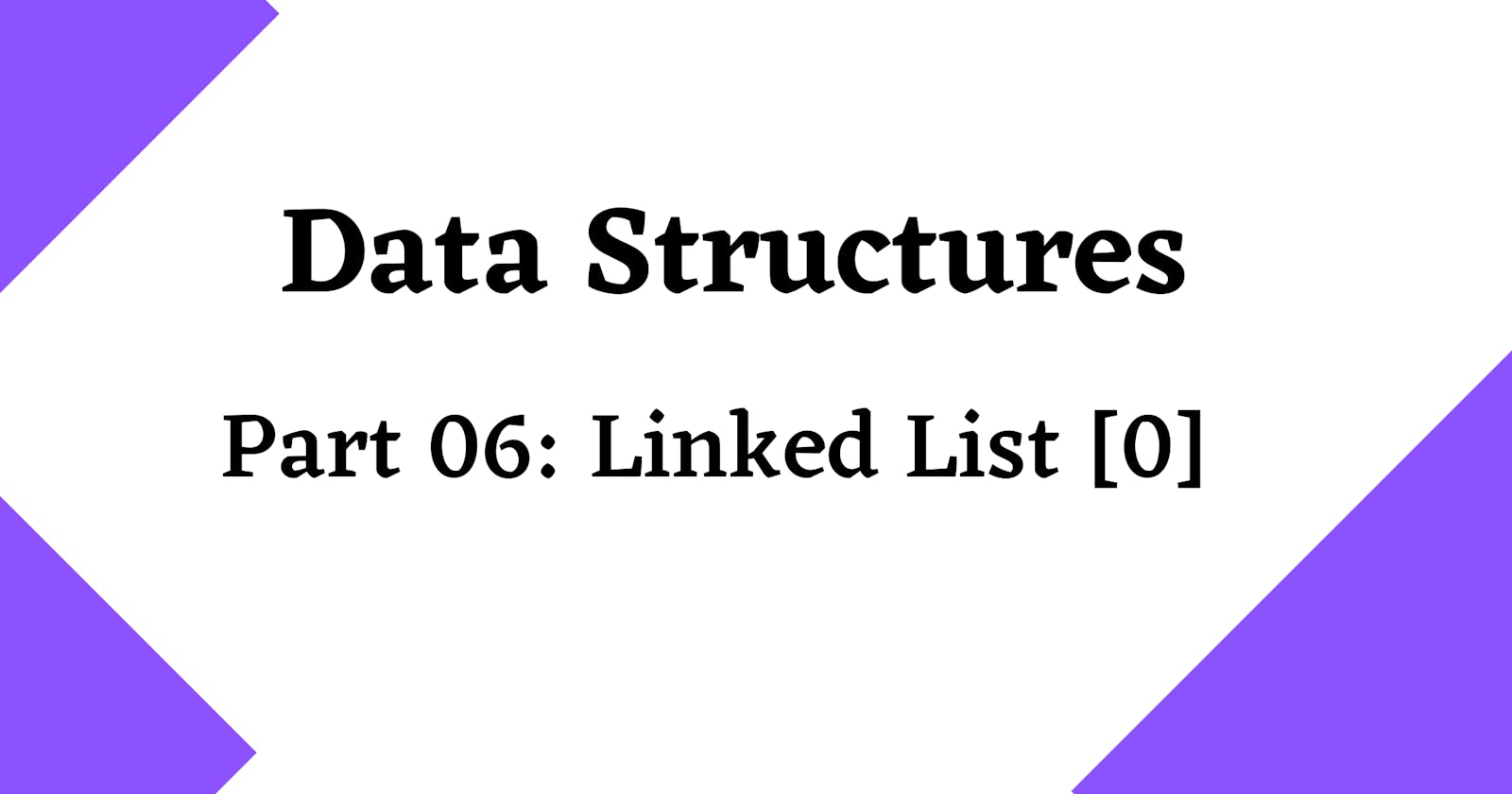Hello everyone! Hope you are doing good ✨
This is the first part of the Linked List Data structure where we will understand what is a linked list and its four operations. For advance operations, please read second part here
In our second article of the Data Structure 101 series, we learned about Arrays. We learned that whenever we want to store data in an organized form, we can use Arrays. But there are several reasons arrays are not always the best data structure to use for organizing data.
In many programming languages, arrays are fixed in length, so it is hard to add new data when the last element of the array is reached. Also, adding and removing data from an array is difficult because you have to move array elements up or down to reflect either an addition or a deletion.
Therefore, we need a more efficient data structure that can be used to store data in an organized form. Luckily, we have one! 😁
Definition ✨
A linked list is a collection/list of nodes. Each node is linked to a successor node in the list using a reference.
Every node has two parts:
- Data.
- Reference of next node.

Image Credits: programiz.com
Important Concept ✨
The linked list can be used in almost every situation where a one-dimensional array is used.
The first node of the linked list is called
head.- The last node of the linked list is called
tail. tailhas alwaysnullas thenextreference because it's the last element.- The
nextis always pointing to the successor node in the list.
Types Of Linked List ✨
Singly Linked List
In Singly Linked List, the node has only one reference to the next node in the list. We are going to cover it in this post.
Doubly Linked List
In Doubly Linked List, the node has two references. One to the next node and one of the previous node.
Time Complexity ✨
| Operation | Time Complexity |
| Insertion | O(1) |
| Deletion | O(1) |
| Search | O(n) |
| Access | O(n) |
Space Complexity of Linked List: O(n)
Applications Of Linked List ✨
- Linked List is heavily used to create stacks and queues.
- When you need constant-time insertions/deletions from the list.
- When the size of the list is unknown. This means you don't know how much your list is going to be scaled, then use Linked List instead of Arrays.
- When you don't need random access to the elements.
- Remember Priority Queue? You can use a linked list to insert elements in between the list as we do in a priority queue.
Coding a Linked List in JavaScript ✨
Let's take a look at how to create a Linked List using my favorite language JavaScript.
Let's create a node class that is going to represent a node in the linked list.
class Node {
constructor(value) {
this.value = value;
this.next = null;
}
}
We have created a Node class and inside the constructor of it, we have initialized two properties.
value- The value of the node. It's the data that we want to store inside the node.next- This will contain the reference of the next node. Initially, it's alwaysnull.
Now that we have the Node class in place, let's create the LinkedList class that will contain the operations of our linked list.
class LinkedList {
constructor() {
this.head = null;
this.tail = null;
this.length = 0;
}
}
We have created a class LinkedList and inside the constructor method, we are initializing three things.
head: The start node or the first node of the linked list.tail: The last node of the linked list.length: A property to store the length of the linked list.
Let's code some operations of the linked list now! ✅
push
In push, we insert a node at the end of the linked list.
Here are the steps which we are going to follow while coding push.
- Create a new method
pushthat accepts avalueas an argument. - Create a new node using the
Nodeclass with thevaluepassed in. - Check if the list is already empty?
- If the list is empty, then assign the new node to the
headandtail. Because right now, we have only one node that isheadandtailboth simultaneously.
- If the list is empty, then assign the new node to the
- If the list is not empty then:
- Assign the
nextproperty of the currenttailto the new node. - Assign the new node to the
tailitself. - Increment the
lengthby 1.
- Assign the
push(value) {
// Node Creation
const newNode = new Node(value);
if (!this.head) {
// check if list is empty?
this.head = newNode; // new head
this.tail = newNode; // new tail
this.length++;
return this;
}
// on the `next` of last node, add the reference to new node.
this.tail.next = newNode;
// update the last node by the new node.
this.tail = newNode;
// Increment the length;
this.length++;
return this;
}
pop
In pop, we delete a node from the end of the linked list.
Here are the steps which we are going to follow while coding pop.
- Create a new method
popthat accepts nothing. - Check if the list is already empty?
- If the list is empty, then return (Nothing to be removed).
- If the list is not empty, then we have to calculate second last element because we will set the
tailof a linked list to the second last element and remove the last one by setting the next propertynullon the current tail. - Decrement the
lengthby one. - If the
lengthof the linked list is 0, that means that we have deleted everything from the linked list. So set theheadandtailtonull.
pop() {
// if the head is null, then return null;
if (!this.head) {
return;
}
// calculate the second last node.
let currentNode = this.head;
let secondLastNode = this.head;
while (currentNode.next) {
secondLastNode = currentNode;
currentNode = currentNode.next;
}
// set the second last node to the new tail of the linked list.
this.tail = secondLastNode;
// set the current tail's next to null;
this.tail.next = null;
// decrement the length
this.length--;
// if the length is `this.length` 0 then reset the linked list
if (this.length === 0) {
this.head = null;
this.tail = null;
}
return this;
}
shift
In shift, we remove a node at the start of the linked list.
Here are the steps which we are going to follow while coding shift.
- If the
headis empty, then return. - We will store the current
headin a variable calledremovedHead. - We will set the current
headto thenextofremovedHead. - Decrement the
lengthby one. - If the
lengthis 0, then set the tail tonull
shift() {
// check if there is no head then return;
if (!this.head) return;
// store the current head in a variable.
const removedHead = this.head;
// store the next node of head to be the current head
this.head = removedHead.next;
// decrement the length
this.length--;
// if length is 0, then reset the list
if (this.length === 0) {
this.tail = null;
this.head = null;
}
return this;
}
unshift
In unshift, we add a node at the start of the linked list.
Here are the steps which we are going to follow while coding unshift.
- Create a method
shiftin the class which is going to accept thevalueof the node as an argument. - Create a new node from the
Nodeclass. - If the
headis empty, then make theheadandtailthe new node. - Set the
nextproperty on the new node to the currenthead. - Set the new node as the new
headof the linked list. - Increment the
lengthby one.
unshift(value) {
// create a new node
const newNode = new Node(value);
// if the head is empty, make the new node the head and tail (first node).
if (!this.head) {
this.head = newNode;
this.tail = newNode;
this.length++;
return;
}
// Otherwise, set the next to of new node to current head
newNode.next = this.head;
// set the current head of list to new node
this.head = newNode;
// increment the length
this.length++;
return newNode;
}
That's it, folks! hope the first part was a good read for you. Thank you! ✨

